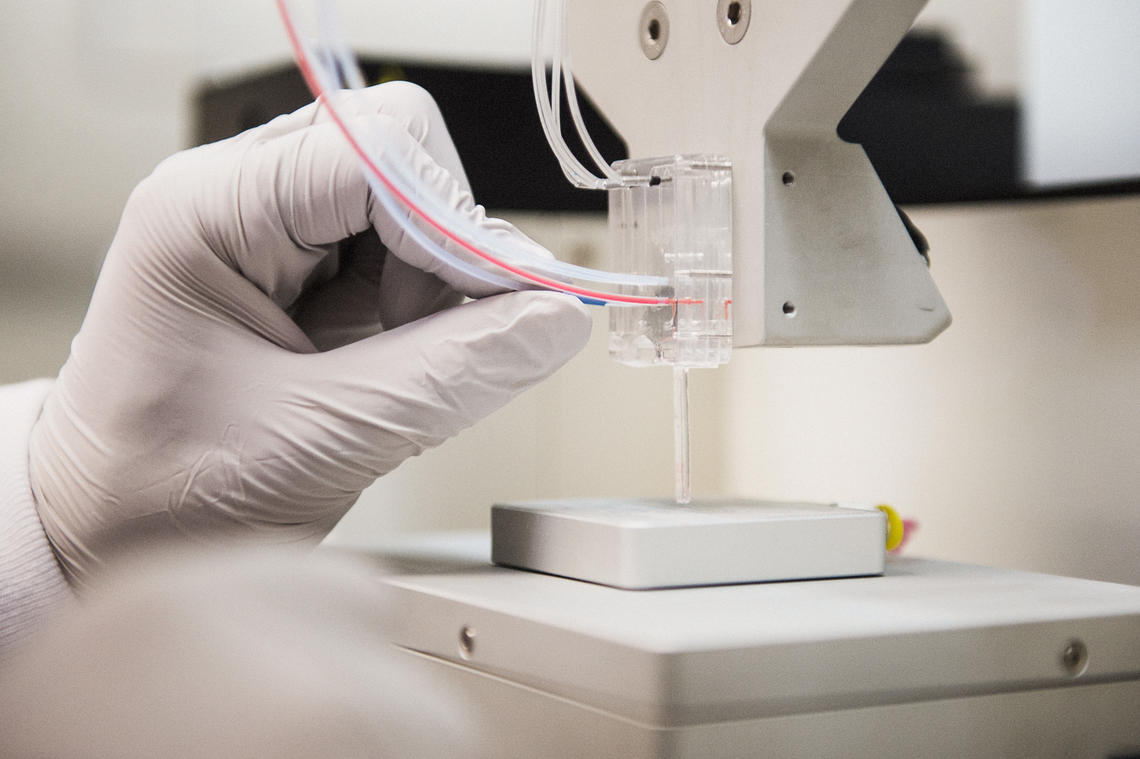
Nov. 23, 2021
3D printing living tissue to treat diabetes is closer to clinical trials
A UCalgary researcher’s decades-long work developing technology for 3D bioprinting living pancreatic tissues has taken a huge leap forward, through a growing relationship with the Vancouver biotechnology company Aspect Biosystems. Dr. Mark Ungrin, PhD, and his lab in the University of Calgary Faculty of Veterinary Medicine (UCVM) developed human pancreatic islets — pseudoislets — to give them a better chance of survival when transplanted into people with Type 1 diabetes.
“I am very pleased about it all as it is exactly the sort of application my research program has been working towards since I started my lab in Calgary,” says Ungrin, associate professor in the Department of Comparative Biology and Experimental Medicine at UCVM.
I am optimistic that this will lead to clinical translation in the not-too-distant future.
Ungrin’s lab designed the pseudoislets as a way to package islet cells — normally found in the pancreas, where they regulate blood sugar levels — with controlled and reproducible size, and improved survival and function both in culture and after transplant. Dr. Yang Yu, who led the studies during his PhD in the University of Calgary’s Biomedical Engineering graduate program under Ungrin’s supervision, was recruited by Aspect Biosystems to integrate the cell repackaging processes into their work 3D bioprinting pancreatic and other live tissues.

Mark Ungrin, right, and his at-that-time PhD student Yang Yu, engineered technology to reorganize human pancreas cells for more successful transplantation.
University of Calgary
“I am helping establish the technology Mark and I developed into Aspect’s very exciting 3D bioprinting process,” says Yu. “I am working to enhance the uniformity of therapeutic tissues. We are expanding toward other therapeutic programs such as the liver and I am stepping to a role with additional responsibility to work on ensuring both quality and quantity in our bioprocessing as we are getting closer towards the clinic.”
The pseudoislet work relies on microscale tissue engineering technology, AggreWell, invented previously by Ungrin and now in use around the world. This technology assembles cells into clusters with controlled size and composition, allowing cells to help each other function, and survive. Aspect is leveraging this technology to improve the function of their implantable pancreatic tissues.
Aspect Biosystems demonstrates 'long-term tissue function'
The company recently presented data highlighting successful regulation of blood glucose in animal models of Type 1 diabetes for 90 days after implantation, at the International Pancreas and Islet Transplant Association (IPITA) conference.
“We have significantly advanced our development of a cell-based bioprinted pancreas therapeutic by using in vitro and in vivo studies to demonstrate long-term tissue function and efficacy in restoring blood glucose to completely normal levels in animal models of Type 1 diabetes,” says Dr. Sam Wadsworth, Aspect’s chief scientific officer. “We look forward to advancing our bioprinted therapeutic program towards clinical evaluation and, ultimately, introducing a transformative cure for diabetic patients dependent on insulin injections.”

Aspect Biosystem is working to advance its bioprinted therapeutic program towards clinical evaluation and, “ultimately, introducing a transformative cure for diabetic patients dependent on insulin injections.”
Aspect Biosystems
The pseudoislet work now employed in Aspect’s march toward clinical trials and game-changing diabetes treatment was supported by CIHR, UCVM/CBEM, ACHRI, the Alberta Diabetes Institute, and Canada’s Stem Cell Network. Yu received an ADI studentship and a four-month MITACS internship at the University of Oxford that coincided with Ungrin’s sabbatical as a visiting researcher at the Oxford Centre for Diabetes, Endocrinology and Metabolism.
Planning the path to the clinic
“Early in my program, I was thinking I didn’t want to stay in academia too long,” says Yu. “I was oriented toward industry. I really appreciate the training and mentorship I received from Mark. What I learned and received have enabled me to pursue my career at Aspect doing meaningful and valuable work together with like-minded people.” Ungrin impressed on Yu the need to plan ahead regarding where the research could go.
“This is not random in the sense that Aspect stumbled across what we do and coincidentally it was useful to them,” says Ungrin. “Our original pseudoislet research was very much informed by thinking ahead around what the path to the clinic looks like.”
That includes talking with Health Canada and attending workshops to understand the regulatory pathway and future trial design. “Translation doesn't happen by accident,” says Ungrin. “It requires a long-term and very interdisciplinary strategy and sustained support to bridge that gap.”
Ungrin encourages every one of his students to think about the result of their work, whether it be pure knowledge or a concrete application for a specific disease. “If they are serious about translation, I encourage students to think about how they could actually get there. The difference between aspiration and innovation is a long-term plan.”
Mark Ungrin is a member of the Alberta Children’s Hospital Research Institute (ACHRI), the Biomedical Engineering Graduate Program, and the Centre for Bioengineering Research and Education at the University of Calgary, as well the Alberta Diabetes Institute.
The University of Calgary’s multidisciplinary Engineering Solutions for Health: Biomedical Engineering research strategy drives innovations that are saving lives and revolutionizing health care for Canadians. With collaborative teams focused on human mobility, health monitoring, advanced biomedical imaging, precision biodiagnostics, regenerative medicine and novel medical technologies, our researchers are transforming quality of life and continuously improving the health system.






